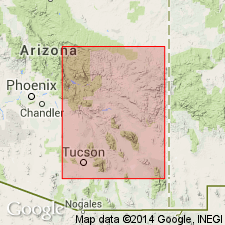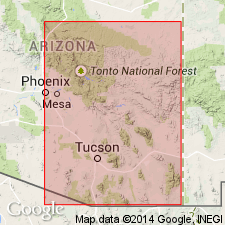
- Usage in publication:
-
- Galiuro limestone
- Modifications:
-
- Named
- Dominant lithology:
-
- Limestone
- AAPG geologic province:
-
- Basin-and-Range province
Summary:
Named for Galiuro Mountains, AZ. Suggested as name for Pennsylvanian limestones included in upper part of Tornado limestone.
Source: GNU records (USGS DDS-6; Denver GNULEX).

- Usage in publication:
-
- Galiuro limestone
- Modifications:
-
- Named
- Biostratigraphic dating
- Dominant lithology:
-
- Limestone
- AAPG geologic province:
-
- Basin-and-Range province
Summary:
Named for Galiuro Mountains, AZ. Stratotype is at the junction of the Gila and San Pedro Rivers at the foot of Saddle Mountain. [Although not clearly stated, the author probably intended the Galiuro to be used over an extensive area to the east, west, and north of the Galiuro Mountains.] Named to replace upper (Pennsylvanian) part of Tornado limestone. Basal 40 ft is arenaceous and argillaceous shale with layers of limestone at top. Generally fossiliferous and frequently cherty white, yellow, brown, and pink limestone lie above. Upper part consists of thinner-bedded, pink and brown compact limestone. About 950 ft thick. [Upper and lower boundaries not described.] Contains abundant Pennsylvanian fossils.
Source: GNU records (USGS DDS-6; Denver GNULEX).
For more information, please contact Nancy Stamm, Geologic Names Committee Secretary.
Asterisk (*) indicates published by U.S. Geological Survey authors.
"No current usage" (†) implies that a name has been abandoned or has fallen into disuse. Former usage and, if known, replacement name given in parentheses ( ).
Slash (/) indicates name conflicts with nomenclatural guidelines (CSN, 1933; ACSN, 1961, 1970; NACSN, 1983, 2005, 2021). May be explained within brackets ([ ]).

